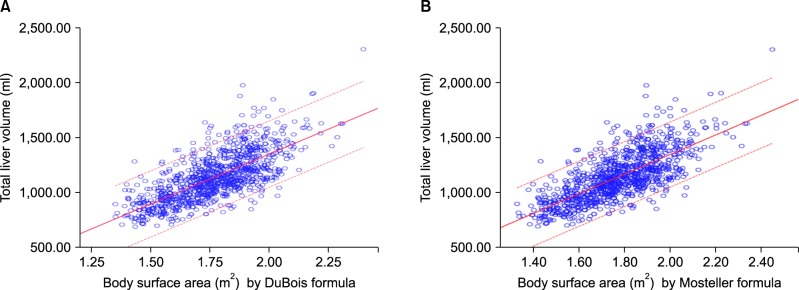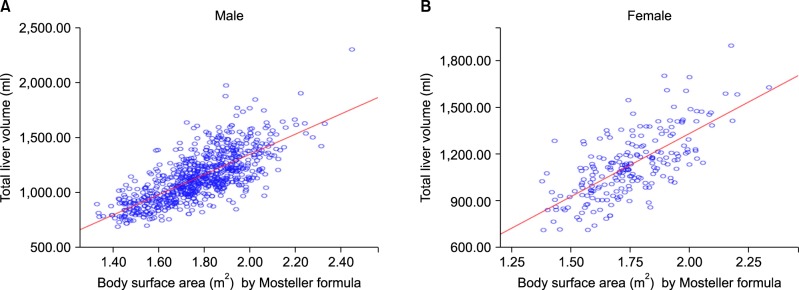Korean J Hepatobiliary Pancreat Surg.
2015 Nov;19(4):133-138. 10.14701/kjhbps.2015.19.4.133.
Calculation of standard liver volume in Korean adults with analysis of confounding variables
- Affiliations
-
- 1Department of Surgery, Asan Medical Center, University of Ulsan College of Medicine, Seoul, Korea. shwang@amc.seoul.kr
- KMID: 2130964
- DOI: http://doi.org/10.14701/kjhbps.2015.19.4.133
Abstract
- BACKGROUNDS/AIMS
Standard liver volume (SLV) is an important parameter that has been used as a reference value to estimate the graft matching in living donor liver transplantation (LDLT). This study aimed to determine a reliable SLV formula for Korean adult patients as compared with the 15 SLV formulae from other studies and further estimate SLV formula by gender and body mass index (BMI).
METHODS
Computed tomography liver volumetry was performed in 1,000 living donors for LDLT and regression formulae for SLV was calculated. Individual donor data were applied to the 15 previously published SLV formulae, as compared with the SLV formula derived in this study. Analysis for confounding variables of BMI and gender was also performed.
RESULTS
Two formulae, "SLV (ml)=908.204xBSA-464.728" with DuBois body surface area (BSA) formula and "SLV (ml)=893.485xBSA-439.169" with Monsteller BSA formula, were derived by using the profiles of the 1,000 living donors included in the study. Comparison with other 15 other formulae, all except for Chouker formula showed the mean volume percentage errors of 4.8-5.4%. The gender showed no significant effect on total liver volume (TLV), but there was a significant increase in TLV as BMI increased.
CONCLUSIONS
Our study suggested that most SLV formulae showed a crudely applicable range of SLV estimation for Korean adults. Considering the volume error in estimating SLV, further SLV studies with larger population from multiple centers should be performed to enhance its predictability. Our results suggested that classifying SLV formulae by BMI and gender is unnecessary.
MeSH Terms
Figure
Cited by 3 articles
-
Estimation of Standard Liver Volume Using CT Volume, Body Composition, and Abdominal Geometry Measurements
Xiaopeng Yang, Jae Do Yang, Seunghoon Lee, Hong Pil Hwang, Sungwoo Ahn, Hee Chul Yu, Heecheon You
Yonsei Med J. 2018;59(4):546-553. doi: 10.3349/ymj.2018.59.4.546.A new formula for estimation of standard liver volume using liver height and thoracic width
Xiaopeng Yang, Mi Rin Lee, Jae Do Yang
Ann Surg Treat Res. 2022;103(1):47-52. doi: 10.4174/astr.2022.103.1.47.Motion Management and Image-Guided Technique in Photon Radiation Therapy: A Review of an Advanced Technology
Jin Jegal, Hyojun Park, Seonghee Kang, Chang Heon Choi, Jung-in Kim
Prog Med Phys. 2024;35(2):21-35. doi: 10.14316/pmp.2024.35.2.21.
Reference
-
1. Pomposelli JJ, Tongyoo A, Wald C, Pomfret EA. Variability of standard liver volume estimation versus software-assisted total liver volume measurement. Liver Transpl. 2012; 18:1083–1092. PMID: 22532341.
Article2. Urata K, Kawasaki S, Matsunami H, Hashikura Y, Ikegami T, Ishizone S, et al. Calculation of child and adult standard liver volume for liver transplantation. Hepatology. 1995; 21:1317–1321. PMID: 7737637.
Article3. Mosteller RD. Simplified calculation of body-surface area. N Engl J Med. 1987; 317:1098. PMID: 3657876.
Article4. World Health Organization Western Pacific Region, IASO, International Obesity Task Force. Redefining obesity and its treatment. Australia: Health Communications;2000. p. 56.5. DeLand FH, North WA. Relationship between liver size and body size. Radiology. 1968; 91:1195–1198. PMID: 5699624.
Article6. Noda T, Todani T, Watanabe Y, Yamamoto S. Liver volume in children measured by computed tomography. Pediatr Radiol. 1997; 27:250–252. PMID: 9126583.
Article7. Lin XZ, Sun YN, Liu YH, Sheu BS, Cheng BN, Chen CY, et al. Liver volume in patients with or without chronic liver diseases. Hepatogastroenterology. 1998; 45:1069–1074. PMID: 9756008.8. Heinemann A, Wischhusen F, Püschel K, Rogiers X. Standard liver volume in the Caucasian population. Liver Transpl Surg. 1999; 5:366–368. PMID: 10477836.
Article9. Vauthey JN, Abdalla EK, Doherty DA, Gertsch P, Fenstermacher MJ, Loyer EM, et al. Body surface area and body weight predict total liver volume in Western adults. Liver Transpl. 2002; 8:233–240. PMID: 11910568.
Article10. Yoshizumi T, Gondolesi GE, Bodian CA, Jeon H, Schwartz ME, Fishbein TM, et al. A simple new formula to assess liver weight. Transplant Proc. 2003; 35:1415–1420. PMID: 12826175.
Article11. Yu HC, You H, Lee H, Jin ZW, Moon JI, Cho BH. Estimation of standard liver volume for liver transplantation in the Korean population. Liver Transpl. 2004; 10:779–783. PMID: 15162473.
Article12. Choukèr A, Martignoni A, Dugas M, Eisenmenger W, Schauer R, Kaufmann I, et al. Estimation of liver size for liver transplantation: the impact of age and gender. Liver Transpl. 2004; 10:678–685. PMID: 15108261.
Article13. Johnson TN, Tucker GT, Tanner MS, Rostami-Hodjegan A. Changes in liver volume from birth to adulthood: a meta-analysis. Liver Transpl. 2005; 11:1481–1493. PMID: 16315293.
Article14. Hashimoto T, Sugawara Y, Tamura S, Hasegawa K, Kishi Y, Kokudo N, et al. Estimation of standard liver volume in Japanese living liver donors. J Gastroenterol Hepatol. 2006; 21:1710–1713. PMID: 16984594.
Article15. Chan SC, Liu CL, Lo CM, Lam BK, Lee EW, Wong Y, et al. Estimating liver weight of adults by body weight and gender. World J Gastroenterol. 2006; 12:2217–2222. PMID: 16610024.
Article16. Yuan D, Lu T, Wei YG, Li B, Yan LN, Zeng Y, et al. Estimation of standard liver volume for liver transplantation in the Chinese population. Transplant Proc. 2008; 40:3536–3540. PMID: 19100432.
Article17. Fu-Gui L, Lu-Nan Y, Bo L, Yong Z, Tian-Fu W, Ming-Qing X, et al. Estimation of standard liver volume in Chinese adult living donors. Transplant Proc. 2009; 41:4052–4056. PMID: 20005340.
Article
- Full Text Links
- Actions
-
Cited
- CITED
-
- Close
- Share
- Similar articles
-
- Calculation of Standard Liver Volume of Korean Adults
- A new formula for estimation of standard liver volume using liver height and thoracic width
- Liver volume determination by ultrasound
- Comparison of skeletal muscle index and body surface area-based formulae for estimation of standard liver volume
- The mensuration of the liver weight and relative liver weight in the Korean adults



